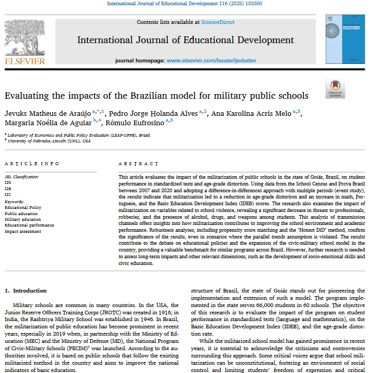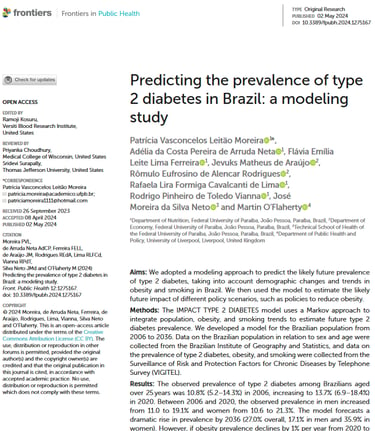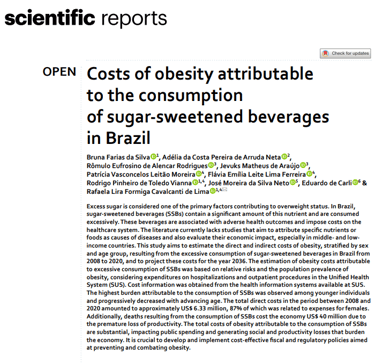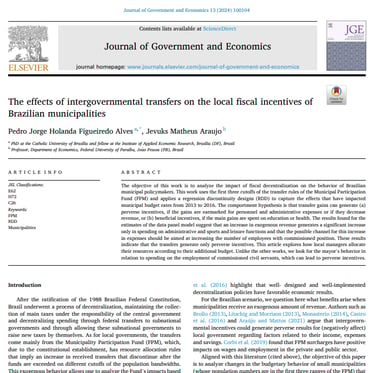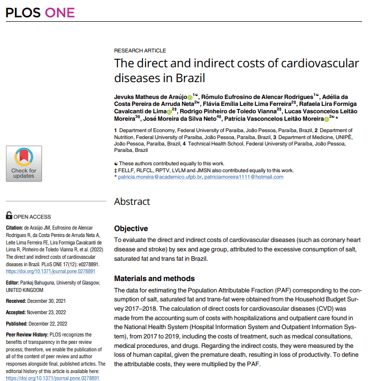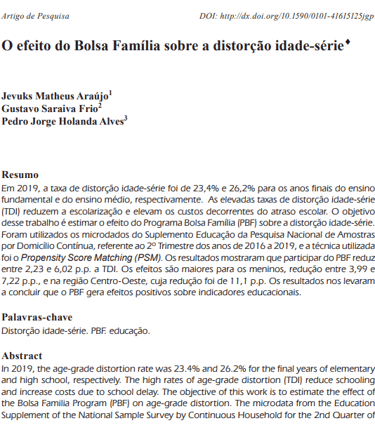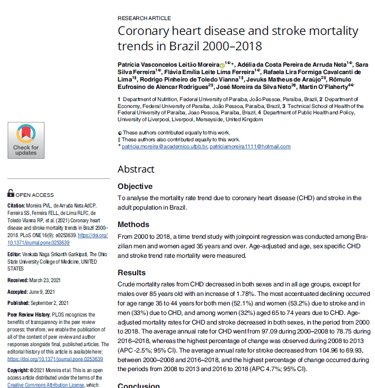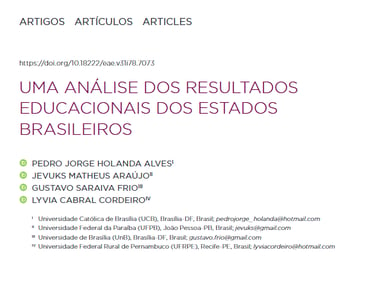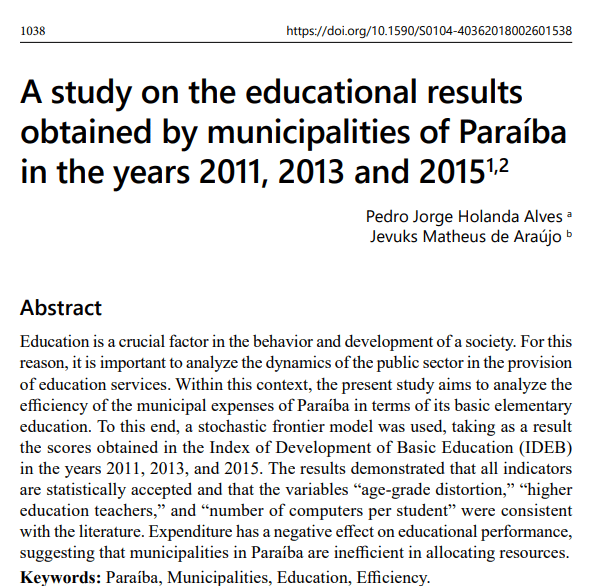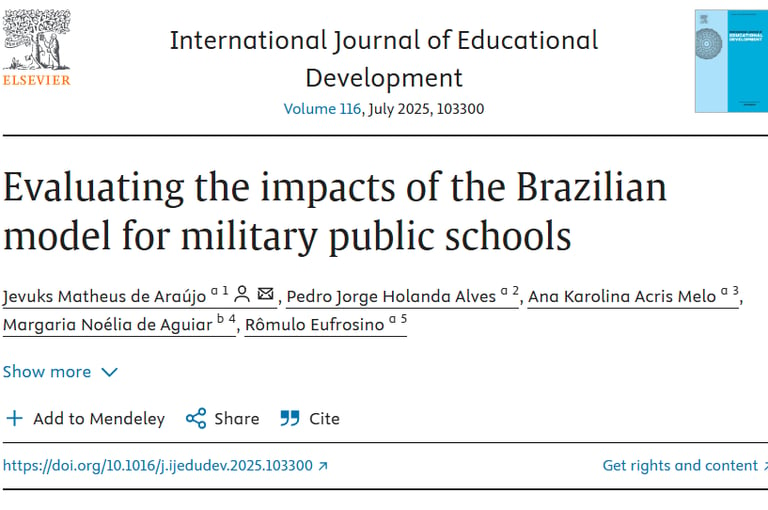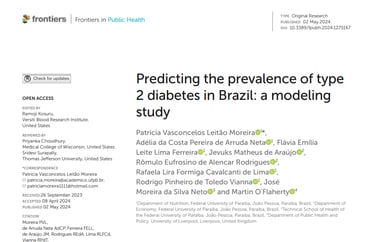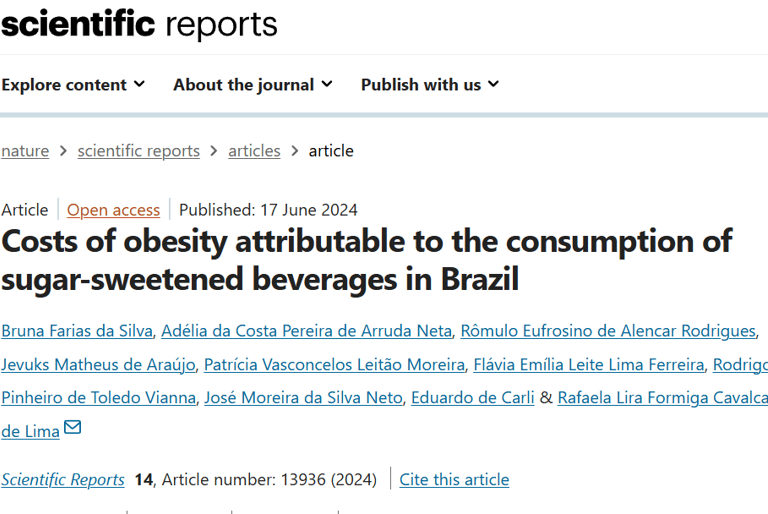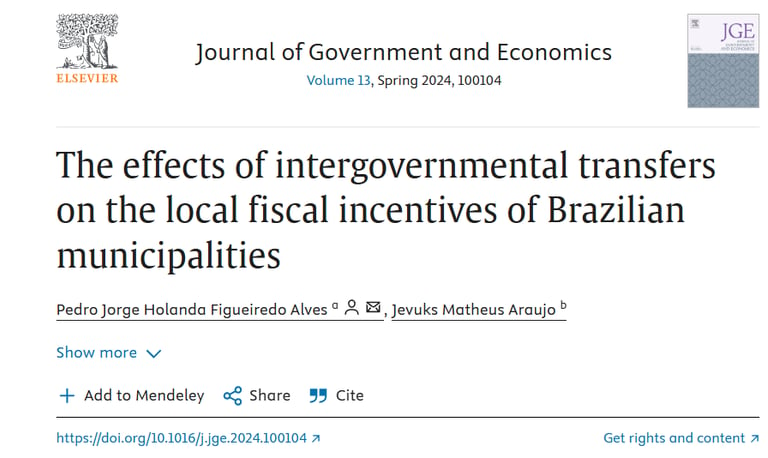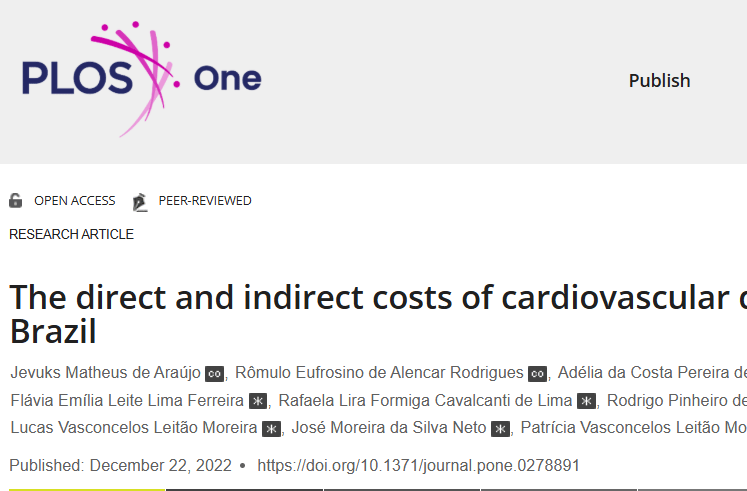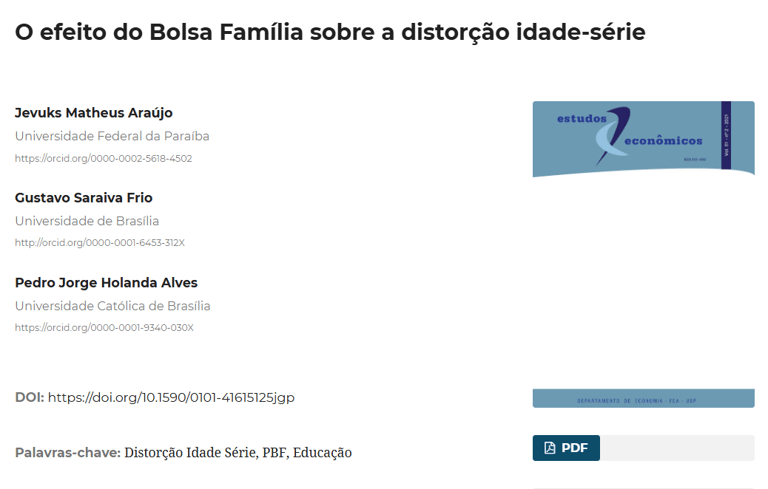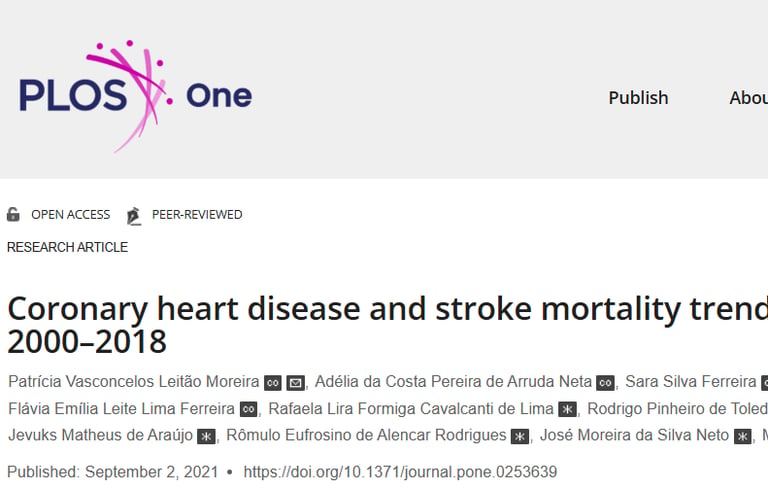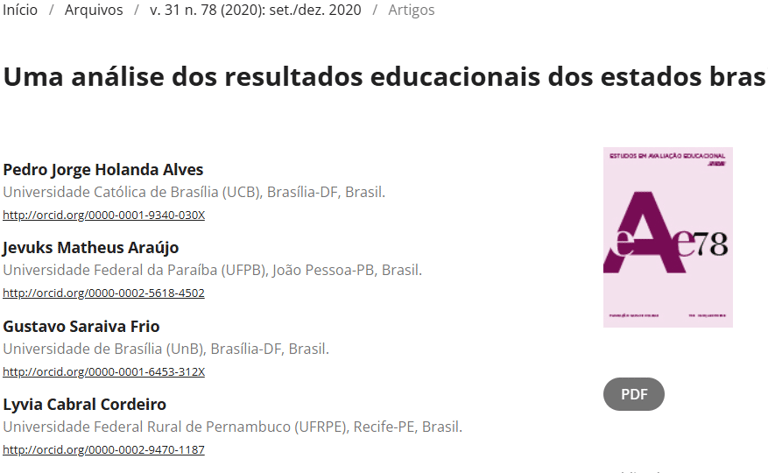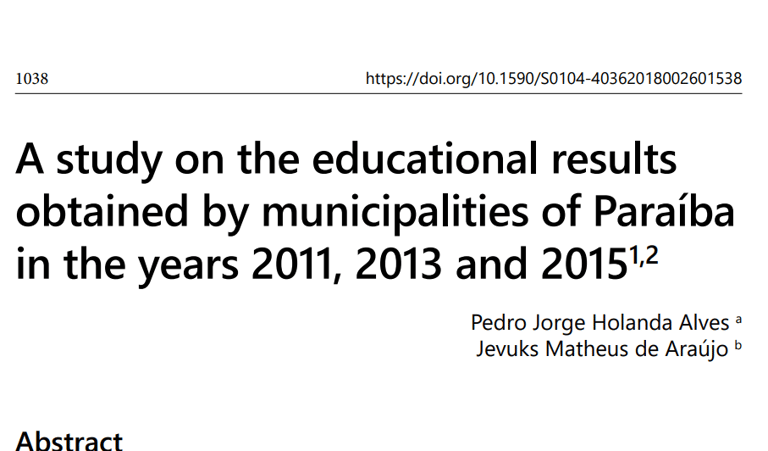Research Articles
Evaluating the impacts of the Brazilian model for military public schools
Abstract: This paper evaluates the impact of the militarization of public schools in Goiás between 2007 and 2020. The findings show a reduction in age–grade distortion, improvements in performance in Mathematics, Portuguese, and IDEB scores, as well as a decline in school violence incidents. The evidence suggests that the school environment became safer and more conducive to learning.
Authors: Jevuks Matheus de Araújo, Pedro Jorge Holanda Alves, Ana Karolina Acris Melo, Margaria Noélia de Aguiar e Rômulo Eufrosino de Alencar Rodrigues.
Year: 2025
Predicting the prevalence of type 2 diabetes in Brazil: a modeling study
Abstract: The predictive model estimated that the prevalence of type 2 diabetes in Brazil will increase significantly by 2036, potentially affecting 27% of the adult population, with a particularly high impact among women. This growth is associated with demographic trends, obesity, and smoking. Even under effective obesity-reduction policies, with annual declines of 1% to 5%, prevalence would remain high. The study highlights the urgency of integrated, long-term strategies to contain the spread of the disease in the country.
Authors: Patrícia Vasconcelos Leitão Moreira; Adélia da Costa Pereira de Arruda Neta, Flávia Emília Leite Lima Ferreira, Jevuks Matheus de Araújo, Rômulo Eufrosino de Alencar Rodrigues, Rafaela Lira Formiga Cavalcanti de Lima, Rodrigo Pinheiro de Toledo Vianna, José Moreira da Silva Neto e Martin O'Flaherty.
Year: 2024
Costs of obesity attributable to the consumption of sugar-sweetened beverages in Brazil
Abstract: The study estimates that, between 2008 and 2020, excessive consumption of sugar-sweetened beverages generated direct costs of US$ 6.33 million for Brazil’s Unified Health System (SUS) and productivity losses of US$ 40 million, affecting mainly women and young people. Obesity attributable to these beverages places a substantial burden on both the healthcare system and the Brazilian economy. Effective public policies are urgently needed to mitigate the health and economic impacts of this issue.
Authors: Bruna Farias da Silva, Adélia da Costa Pereira de Arruda Neta, Rômulo Eufrosino de Alencar Rodrigues, Jevuks Matheus de Araújo, Patrícia Vasconcelos Leitão Moreira, Flávia Emília Leite Lima Ferreira, Rodrigo Pinheiro de Toledo Vianna, José Moreira da Silva Neto, Eduardo de Carli e Rafaela Lira Formiga Cavalcanti de Lima.
Year: 2024
The direct and indirect costs of cardiovascular diseases in Brazil
Abstract: The study estimated the economic costs of cardiovascular diseases attributable to excessive consumption of salt, saturated fat, and trans fat in Brazil. Between 2017 and 2019, total costs reached US$ 7.18 billion, with a loss of 1.53 million productive years due to premature deaths. The greatest impact was observed among men aged 45 to 74, particularly in direct costs. Salt was the nutrient with the highest impact, followed by saturated and trans fats.
Authors: Jevuks Matheus de Araújo, Rômulo Eufrosino de Alencar Rodrigues, Adélia da Costa Pereira de Arruda Neta, Flávia Emília Leite Lima Ferreira, Rafaela Lira Formiga Cavalcanti de Lima, Rodrigo Pinheiro de Toledo Vianna, Lucas Vasconcelos Leitão Moreira, José Moreira da Silva Neto e Patrícia Vasconcelos Leitão Moreira.
Year: 2022
Coronary heart disease and stroke mortality trends in Brazil 2000–2018
Abstract: Between 2000 and 2018, mortality rates from coronary heart disease and stroke declined among Brazilian adults, except for men over 85 years old. The most pronounced reductions were observed among individuals aged 35 to 44. Age-adjusted rates also decreased significantly throughout the period. This progress reflects improvements in healthcare and lifestyle, but requires sustained efforts to continue.
Authors: Patrícia Vasconcelos Leitão Moreira, Adélia da Costa Pereira de Arruda Neta, Sara Silva Ferreira, Flávia Emília Leite Lima Ferreira, Rafaela Lira Formiga Cavalcanti de Lima, Rodrigo Pinheiro de Toledo Vianna, Jevuks Matheus de Araújo, Rômulo Eufrosino de Alencar Rodrigues, José Moreira da Silva Neto e Martin O’Flaherty.
Year: 2021
The effects of intergovernmental transfers on the local fiscal incentives of Brazilian municipalities
Abstract: This paper evaluates the impact of fiscal decentralization through the Municipal Participation Fund (FPM) on the behavior of local governments between 2013 and 2016. Using a regression discontinuity design, the study finds that increases in exogenous revenue are primarily allocated to administrative expenses and appointed positions, revealing perverse fiscal incentives.
Authors: Pedro Jorge Holanda Figueiredo Alves e Jevuks Matheus de Araújo.
Year: 2024
O efeito do Bolsa Família sobre a distorção idade-série
Abstract: This paper estimates the impact of the Bolsa Família Program (PBF) on age–grade distortion in Brazil, using microdata from the Continuous PNAD (2nd quarter of 2016 to 2019) and the Propensity Score Matching (PSM) methodology. The results show that participation in PBF reduces age–grade distortion by 2.23 to 6.02 percentage points, with stronger effects among boys (up to 7.22 p.p.) and in the Center-West region (up to 11.1 p.p.). The study reinforces the evidence that the program contributes positively to educational outcomes.
Authors: Jevuks Matheus Araújo, Gustavo Saraiva Frio e Pedro Jorge Holanda Alves.
Year: 2021
Uma análise dos resultados educacionais dos estados brasileiros
Abstract: This paper analyzes educational quality indicators in Brazilian states from 2007 to 2017, focusing on metrics such as IDEB, approval rates, age–grade distortion, and performance in standardized assessments. It seeks to identify regional and temporal patterns and to discuss potential factors influencing the variations observed over the period.
Authors: Pedro Jorge Holanda Alves, Jevuks Matheus Araújo, Gustavo Saraiva Frio e Lyvia Cabral Cordeiro
Year: 2020
A study on the educational results obtained by municipalities of Paraíba in the years 2011, 2013 and 2015
Resumo: This paper analyzes the efficiency of municipal public spending on basic education in Paraíba in the years 2011, 2013, and 2015, using a stochastic frontier model with IDEB as the dependent variable. The results show a negative correlation between public spending and educational performance, indicating inefficient use of resources. Moreover, age–grade distortion is found to reduce IDEB, while an increase in the number of teachers with higher education and in the availability of computers per student improves performance.
Authors: Pedro Jorge Holanda Alves e Jevuks Matheus de Araújo.
Year: 2018
Research Articles
Evaluating the impacts of the Brazilian model for military public schools
Resumo: This paper evaluates the impact of the militarization of public schools in Goiás between 2007 and 2020. The findings show a reduction in age–grade distortion, improvements in performance in Mathematics, Portuguese, and IDEB scores, as well as a decline in school violence incidents. The evidence suggests that the school environment became safer and more conducive to learning..
Authors: Jevuks Matheus de Araújo, Pedro Jorge Holanda Alves, Ana Karolina Acris Melo, Margaria Noélia de Aguiar e Rômulo Eufrosino de Alencar Rodrigues.
Year: 2025
Predicting the prevalence of type 2 diabetes in Brazil: a modeling study
Abstract: The predictive model estimated that the prevalence of type 2 diabetes in Brazil will increase significantly by 2036, potentially affecting 27% of the adult population, with a particularly high impact among women. This growth is associated with demographic trends, obesity, and smoking. Even under effective obesity-reduction policies, with annual declines of 1% to 5%, prevalence would remain high. The study highlights the urgency of integrated, long-term strategies to contain the spread of the disease in the country.
Authors: Patrícia Vasconcelos Leitão Moreira; Adélia da Costa Pereira de Arruda Neta, Flávia Emília Leite Lima Ferreira, Jevuks Matheus de Araújo, Rômulo Eufrosino de Alencar Rodrigues, Rafaela Lira Formiga Cavalcanti de Lima, Rodrigo Pinheiro de Toledo Vianna, José Moreira da Silva Neto e Martin O'Flaherty.
Year: 2024
Costs of obesity attributable to the consumption of sugar-sweetened beverages in Brazil
Abstract: The study estimates that, between 2008 and 2020, excessive consumption of sugar-sweetened beverages generated direct costs of US$ 6.33 million for Brazil’s Unified Health System (SUS) and productivity losses of US$ 40 million, affecting mainly women and young people. Obesity attributable to these beverages places a substantial burden on both the healthcare system and the Brazilian economy. Effective public policies are urgently needed to mitigate the health and economic impacts of this issue.
Authors: Bruna Farias da Silva, Adélia da Costa Pereira de Arruda Neta, Rômulo Eufrosino de Alencar Rodrigues, Jevuks Matheus de Araújo, Patrícia Vasconcelos Leitão Moreira, Flávia Emília Leite Lima Ferreira, Rodrigo Pinheiro de Toledo Vianna, José Moreira da Silva Neto, Eduardo de Carli e Rafaela Lira Formiga Cavalcanti de Lima.
Year: 2024
The direct and indirect costs of cardiovascular diseases in Brazil
Abstract: The study estimated the economic costs of cardiovascular diseases attributable to excessive consumption of salt, saturated fat, and trans fat in Brazil. Between 2017 and 2019, total costs reached US$ 7.18 billion, with a loss of 1.53 million productive years due to premature deaths. The greatest impact was observed among men aged 45 to 74, particularly in direct costs. Salt was the nutrient with the highest impact, followed by saturated and trans fats.
Authors: Jevuks Matheus de Araújo, Rômulo Eufrosino de Alencar Rodrigues, Adélia da Costa Pereira de Arruda Neta, Flávia Emília Leite Lima Ferreira, Rafaela Lira Formiga Cavalcanti de Lima, Rodrigo Pinheiro de Toledo Vianna, Lucas Vasconcelos Leitão Moreira, José Moreira da Silva Neto e Patrícia Vasconcelos Leitão Moreira.
Year: 2022
Coronary heart disease and stroke mortality trends in Brazil 2000–2018
Abstract: Between 2000 and 2018, mortality rates from coronary heart disease and stroke declined among Brazilian adults, except for men over 85 years old. The most pronounced reductions were observed among individuals aged 35 to 44. Age-adjusted rates also decreased significantly throughout the period. This progress reflects improvements in healthcare and lifestyle, but requires sustained efforts to continue.
Authors: Patrícia Vasconcelos Leitão Moreira, Adélia da Costa Pereira de Arruda Neta, Sara Silva Ferreira, Flávia Emília Leite Lima Ferreira, Rafaela Lira Formiga Cavalcanti de Lima, Rodrigo Pinheiro de Toledo Vianna, Jevuks Matheus de Araújo, Rômulo Eufrosino de Alencar Rodrigues, José Moreira da Silva Neto e Martin O’Flaherty.
Year: 2021
The effects of intergovernmental transfers on the local fiscal incentives of Brazilian municipalities
Abstract: This paper evaluates the impact of fiscal decentralization through the Municipal Participation Fund (FPM) on the behavior of local governments between 2013 and 2016. Using a regression discontinuity design, the study finds that increases in exogenous revenue are primarily allocated to administrative expenses and appointed positions, revealing perverse fiscal incentives.
Authors: Pedro Jorge Holanda Figueiredo Alves e Jevuks Matheus de Araújo.
Year: 2024
O efeito do Bolsa Família sobre a distorção idade-série
Abstract: This paper estimates the impact of the Bolsa Família Program (PBF) on age–grade distortion in Brazil, using microdata from the Continuous PNAD (2nd quarter of 2016 to 2019) and the Propensity Score Matching (PSM) methodology. The results show that participation in PBF reduces age–grade distortion by 2.23 to 6.02 percentage points, with stronger effects among boys (up to 7.22 p.p.) and in the Center-West region (up to 11.1 p.p.). The study reinforces the evidence that the program contributes positively to educational outcomes.
Authors: Jevuks Matheus Araújo, Gustavo Saraiva Frio e Pedro Jorge Holanda Alves.
year: 2021
Uma análise dos resultados educacionais dos estados brasileiros
Abstract: This paper analyzes educational quality indicators in Brazilian states from 2007 to 2017, focusing on metrics such as IDEB, approval rates, age–grade distortion, and performance in standardized assessments. It seeks to identify regional and temporal patterns and to discuss potential factors influencing the variations observed over the period.
Authors: Pedro Jorge Holanda Alves, Jevuks Matheus Araújo, Gustavo Saraiva Frio e Lyvia Cabral Cordeiro
Year: 2020
A study on the educational results obtained by municipalities of Paraíba in the years 2011, 2013 and 2015
Abstract: This paper analyzes the efficiency of municipal public spending on basic education in Paraíba in the years 2011, 2013, and 2015, using a stochastic frontier model with IDEB as the dependent variable. The results show a negative correlation between public spending and educational performance, indicating inefficient use of resources. Moreover, age–grade distortion is found to reduce IDEB, while an increase in the number of teachers with higher education and in the availability of computers per student improves performance.
Authors: Pedro Jorge Holanda Alves e Jevuks Matheus de Araújo.
Year: 2018

